SUMMERHOUSE HILL
SUMMERHOUSE HILL
The countryside on Yeovil's doorstep
As anyone who lives here knows, Yeovil has more hills than Rome. However the most spectacular is Summerhouse Hill (also known as Newton Hill), now part of Yeovil Country Park, on the immediate southern edge of the town - the summit stands at 353 feet (107.6m) making it the highest point in Yeovil. Passing its nine specimen oak trees on its steep flank, the walk to the top is well worth the effort and you are rewarded with spectacular views across the town and to the countryside beyond.
On a clear day it is rumoured that you can see the Bristol Channel to the north (I haven’t yet, even with powerful binoculars). More easily visible are the north Dorset Downs to the south, the hills at Montacute to the east, the Exmoor Hills on the horizon to the northwest, the Mendip Hills to the north and the Corton Denham ridge to the northeast.
Traces of medieval farming practices still exist today on the lower slopes of Summerhouse Hill in the form of lynchets.
On the summit is the Summer House, also known as the Round House, which was built by the Harbin family of Newton Surmaville, who owned the hill. It is rumoured that the Summerhouse was built so that they could send messages to the Phelp’s family’s tower on St Michael’s Hill at Montacute to the west. I’m not sure how true that is but the tower on St Michael’s Hill is clearly visible from Summerhouse Hill – check out the second photo in the panoramas above, the tower is visible on the horizon left of centre.
As the town of Yeovil grew dramatically in the nineteenth century, so supplying the town with water became a constant problem. Traditionally the town had relied on numerous wells throughout the town for its water supply, but as the town expanded and its population grew these proved inadequate and summer droughts became a regular feature. In 1897 a huge underground reservoir was constructed on the top of Summerhouse Hill (not that you’d know it was there today) with a capacity of one and a quarter million gallons. However this reservoir and another on Hendford Hill, of 800,000 gallons capacity, ultimately proved to be inadequate for the growing town. Both reservoirs were replaced in 1955 with the construction of Sutton Bingham reservoir, although the Summerhouse Hill reservoir was massively enlarged during the 1980s (see Gallery).
gallery
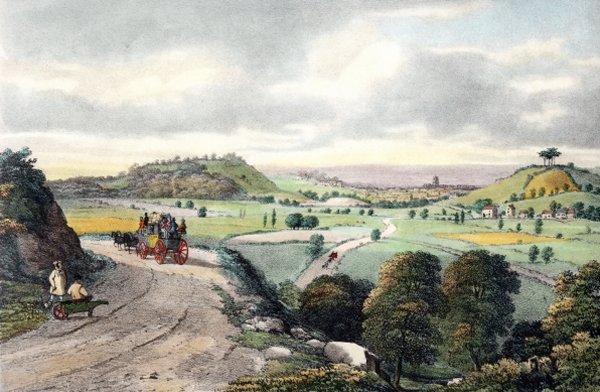
From my
collection
'View of Yeovil from Babylon Hill' in a hand-coloured stone lithograph by Henry Burn (c1807-1884) and published by William Porter and Henry Marsh Custard in January 1839. With Summerhouse Hill at left, Penn Hill behind it surmounted by Penn House, and Wyndham Hill at right. The buildings at Pen Mill are seen at the base of the latter, with the tower of St John's church above and to the left. At centre, a coach is seen on the Sherborne Road before it was re-aligned.
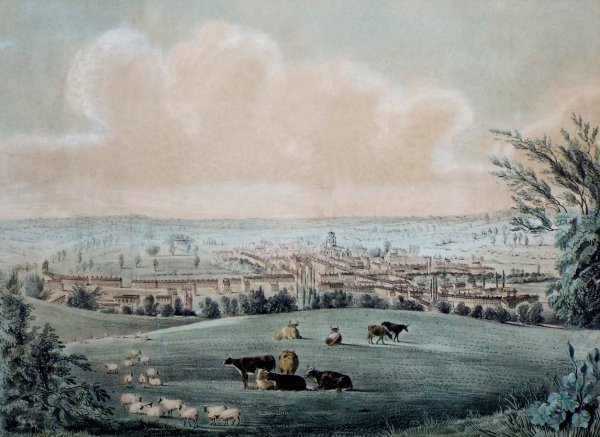
A hand-coloured lithograph entitled "View from Newton Hill" which, at a guess, I would think dates to the 1840s or 1850s.

This engraving is entitled "Yeovil, Somerset from Newton Hill" (sorry about the poor quality) was published by Rock & Co of London. Their sequential reference number, 961, suggests a date of 1849-50, however the train at lower right clearly indicates a date of post-1861. So, did Rock get their sequencing wrong or was the train added at a later date?

From my
collection
This hand-coloured lithograph, entitled "View of Yeovil from Newton Hill" overlooking the new Yeovil Town Railway Station was made about 1861 (clearly just after the Town Station opened). Drawn by Edward Holton Buckler, it was published by Thomas Willy Vincent of Yeovil.
"The town is surrounded on the South East by three remarkable hills - Babylon-hill, Windmill-hill, and Newton-hill. The landscape is also diversified by Newton Copse, the property of George Harbin, Esq., and the beautiful undulating plantations belonging to John Batten, Esq., flanked on the extreme south by some less extensive and elevated grounds, the property of F. Greenham, Esq. From these several points there are prospects so rich in fertility, verdure, and beauty, and smiling prosperity, - such a brightness, a greenness, and a repose, - that the spectator is wrapt in admiration of the view thus spread around and beneath him; and as the hum of distant voices from the busy little town in the valley below reaches his ear, and he looks upon St. John's gray tower, in its hoary age and silent grandeur, rising out of its midst, impressions something akin to adoration force themselves instinctively upon his mind." (Vickery, 1856).
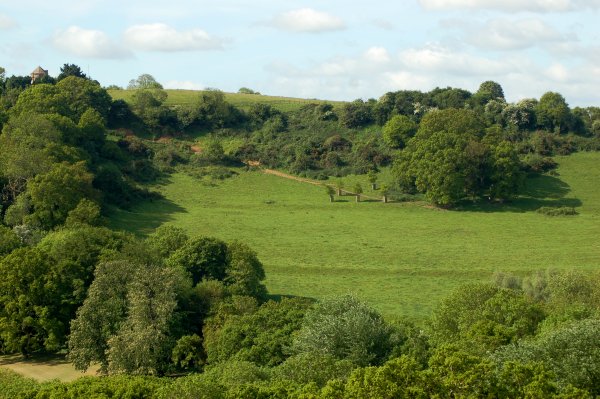
This photograph
features in my
book "A-Z
of Yeovil"
Summerhouse Hill seen from Wyndham Hill. The Summerhouse is visible above the trees at extreme left. Photographed in 2013.

Repairs being undertaken to fissures that developed in Summerhouse Hill's Reservoir No 2. A colourised photograph, taken in October 1897 by John Chaffin.

The reservoir being repaired on the top of the hill in 1897, again by John Chaffin.

This
colourised photograph
features in my
book 'Yeovil
From Old
Photographs'
Another view of the works - everything stops for the photographer!
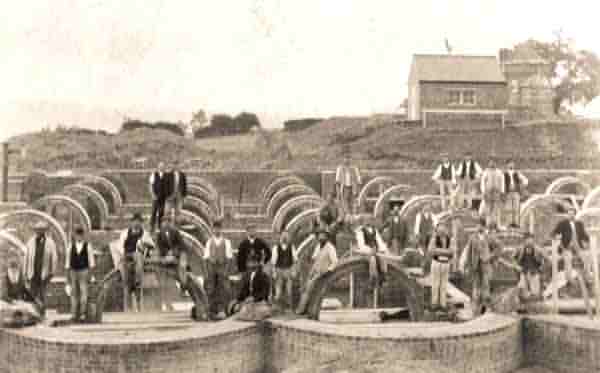
Brickwork arches near completion to support the barrel roof over the reservoir.
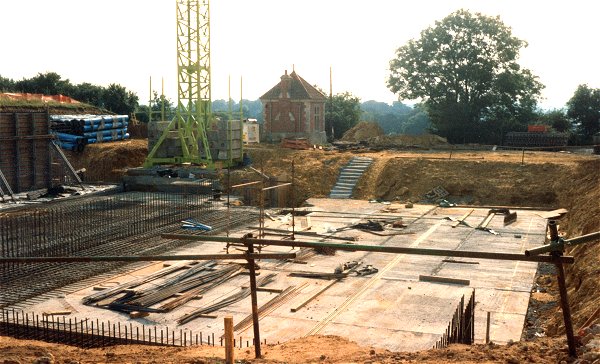
Courtesy of
Colin Haine
The Summerhouse Hill reservoir undergoing a massive redevelopment during the 1980s. Note the Summer House in the background.

A postcard 'Yeovil from Summerhouse Hill' of around 1907 - note the allotments in front of Summerhouse Terrace at bottom right, Talbot Street behind it and Mill Lane at lower left.
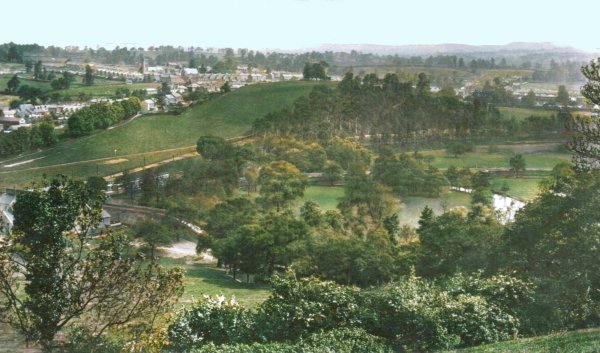
From my
collection
A colourised postcard (the reference number 68919 dates it to 1911) of Wyndham Hill as seen from Summerhouse Hill.

The scene is dominated by glove factories and rows of terraced housing in this photograph of 1940 .
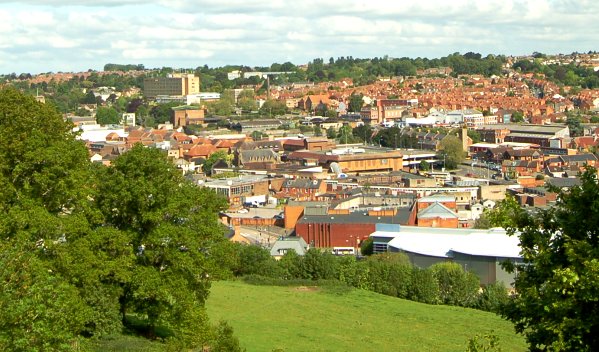
Almost the same view in 2013 (the top of St John's tower is just visible above the tree at extreme left).
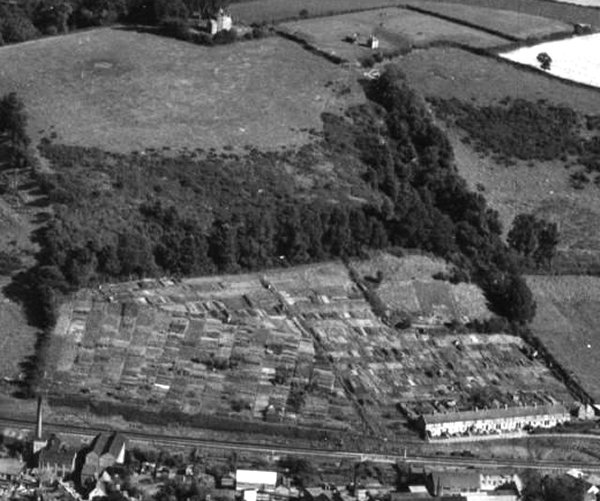
An aerial photograph of 1953 showing the Round House at top left of centre surmounting Summerhouse Hill. The patchwork of the lower slopes of the hill are allotments with the railway line running across the bottom of the photograph. At bottom right are Victoria Buildings.
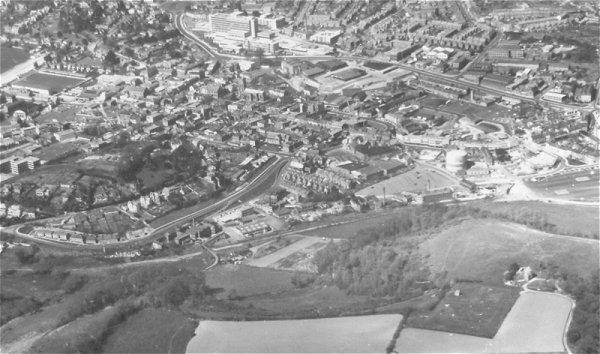
An aerial photograph of the 1960s with Summerhouse Hill and the Round House at bottom right.
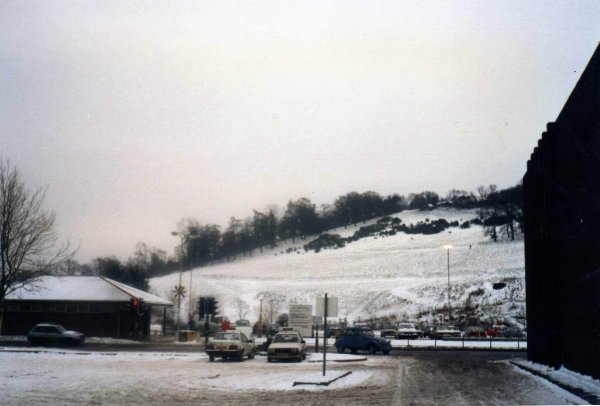
Courtesy of Mark
Rowe
Old Town Station car park and Summerhouse Hill, during winter 1982.

This photograph features in my book 'Secret Yeovil'.
The legacy of medieval farming practices - the remains of lynchets on the side of Newton Hill / Summerhouse Hill. Photographed in 2016.